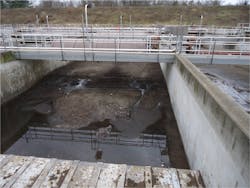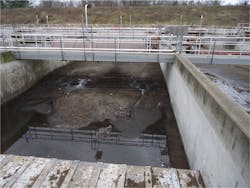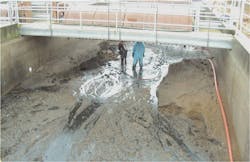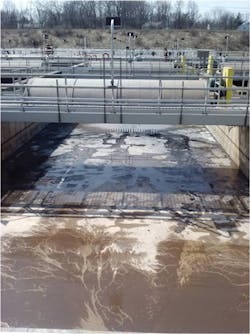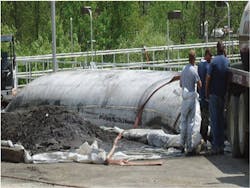How Warren County Defeated the Grit Monster
Few wastewater treatment plants get to experience the disaster of what actually happens if a plant has absolutely no grit removal in operation at the headworks. Over a five-year period, engineers at Warren County, Ohio, discovered the hard way the impact of grit on downstream processes - and the eventual struggle and costs necessary to remove it.
David A Walling, PE, deputy sanitary engineer for the Warren County Water and Sewer Department, first told his story to colleagues at the Southwest Section of the Ohio Water Environment Association in a thought-provoking and openly honest presentation. The tale is only too familiar to the many sanitary engineers who have realized - belatedly - that the grit enemy is creeping up on them.
“I started calling it the ‘grit monster’,” said Walling. “For too long it was like something lurking that you are only aware of in the corner of your vision; it was possible to ignore it. Like many people, we were working under the premise: ‘Grit Removal? Ain’t nobody got time for that!’”
As Walling discovered, grit accumulation in basins increases aeration costs, abrasion of mechanical parts, bearings, shafts, etc., and costs more in O&M. Grit displaces sludge storage capacity and reduces efficiency of solids handling. “At Warren County we now have the evidence, possibly more so than any plant, that grit is a much bigger problem if it is left to pass through the headworks.”
Grit Removal at Warren County
In 1990, the increasing grit loading resulted in the deployment of Warren County’s first proper grit management equipment for the treatment plant. The system was needed to reduce grit loading on the Vertical Loop Reactors (VLR), a modified activated sludge process for biological nutrient removal. In the late 1990s, a second VLR was added to the plant and the system expanded, with each VLR working to a design capacity of 7.2 MGD.
In 2006, flooding problems and equipment failures at the headworks became so troublesome that the grit collection system was effectively bypassed and the grit problem ignored.
How the Grit Monster Was Born
It was what happened in the 2000s that really brought the grit problem to a crisis, Walling explained, and revealed what they had effectively been overlooking until that point.
“We originally considered grit was a bunch of heavy solids with a particle size of over 250 microns that gets washed in with first flush events,” said Walling. “Of course, the heavy component is a large part of it by weight, but you also have to factor in other material like fine abrasive particles, inorganics and organics, floating trash, eggshells, coffee grounds.” There are seeds, bone fragments and other organic food waste particles of all sizes, he continued, and oils and fats solidify around particles and change the way the grit settles out.
“It means grit particles have a wide range of specific gravities, shape and surface area, and particles do not settle like you would necessarily expect,” he said.
By 2005, the grit problem on the site was well recognized and investment plans for a major system upgrade were in the works. By this stage, online treatment capacity had reduced by almost 20 percent, from around 7.2 MGD to 5.8 MGD. Typical of the difficulties was the situation with the coarse bubble aerator system, which was so clogged up with grit that it was ineffective.
In 2006, the operators gave up on the maintenance battle and flooding problems, and the grit collection system was bypassed altogether while maintenance teams held out for the new system to be agreed upon and implemented.
The new design for the headworks plant was expected to take two years to complete, but the plans were delayed for years by the financial crisis.
“Meanwhile the grit monster got to work,” Walling recalled. The inlet screening had now failed almost completely. In the VLR aeration tanks, foaming was building up nearly to the tops of the tanks due to the growth of hydrophobic filamentous organisms in the static anaerobic tank conditions. “We were being dragged down by the grit monster, which eats hydraulic and treatment capacity - and chews up the plant, too,” he said.
Removing Five Years of Grit
With the Phase 3 plant upgrade approved in 2012, the plant had to begin the task of tackling five years of grit accumulation without any removal system.
But removing the accumulated grit proved to be much more difficult than first anticipated. Eventually it was decided to extract the fluidized grit with a ‘honey dipper’ vacuum suction truck and deposit the grit into very large geotextile bags, 2,000 gallons a time, in a temporary plastic-lined containment area. The bags were left until no more liquid emerged, and then cut open so the contents could be trucked out and disposed of. It was a slow, dirty, smelly and unwelcome task.
With approximately 15,000 gallons of capacity, each 45’ x 15’ x 3’ bag contained around 75 cubic yards of dewatered grit at an estimated 1,200 lbs per cubic yard. By the end of the process in 2013, a total of 38 bags of grit had been collected, for a total of roughly 2,773 cubic yards - or 1,386 tons -of grit from two reactors.
Finally, in 2012, with new pretreatment screening now in place, two 12-foot HeadCell® units were installed, each with associated SlurryCup® and Grit Snail™ classification and dewatering equipment, as part of the Phase 3 plant expansion, which had a 12 MGD daily design.
While VLRs 1 and 2 were being degritted, they were offline and a third VLR, installed in 2012 as part of the Phase 3 upgrade, took the whole plant load. Protected by the HeadCell grit removal system, after one year of operation there was virtually no accumulated grit in VLR 3 - despite the whole treatment plant flow going through it while VLR 1 and 2 were offline being cleaned.
With redundant capacity and future-proofing in mind, the grit removal system is capable of alternating operation between the parallel trains. In practice, liquid is kept moving through both the HeadCell units, maintaining optimum settling performance across the surfaces of the stacked trays.
New System Very Effective
“The stacked multi-tray design is very effective at removing grit,” concluded Walling. “Since 2012, we have had minimal grit accumulation in nearly three years, and no accumulation of foam. The massive improvement is plain to see.”
Warren County WWTP is unique in having an absolute measurement of the total grit volume from the aeration tanks alone to calculate a return on investment in an efficient removal system. Walling estimated a savings of $196,802 by removing the same amount of grit through the HeadCell system as was removed in total from the VLRs the old way, notwithstanding the other savings made from avoiding downstream equipment damage.
The grit also had a huge impact on the efficiency of the aeration process. It was estimated to result in a 20 percent reduction in treatment volume in the aerators, with efficiency further compromised by reduced anaerobic conditions, oils and grease accumulation, promotion of hydrophobic organisms, and foaming issues and sludge settling due to filamentous growth.
Walling said his utility learned a number of hard and expensive lessons that every wastewater treatment plant operator should take to heart: “Grit is a 24/7, 365-day battle! If you don’t remove grit in the headworks building, it costs a lot more once it passes down the line. Avoid unnecessary wear and tear on equipment and pay for grit removal up front to keep hydraulic and treatment capacity and efficiency maximized.”
About the Company: Hydro International is a global leader in sustainable technologies for the control and treatment of stormwater and wastewater. With offices in the U.K., U.S., Singapore, China and Ireland, Hydro is strategically placed to deliver winning technological solutions to customers wherever they are in the world.
